Near-Miss Detection Metrics: An Approach to Enable Sensing Technologies for Proactive Construction Safety Management
Abstract
1. Introduction
2. An Overview of Near-Misses
2.1. Near-Miss Definition: Worldwide Perspective
2.2. Near-Miss Incidents in the Construction Sector
2.3. Measures for Detecting Near-Miss Incidents in the Construction Industry
3. Research Approach
3.1. Developing Near-Miss Detection Metrics
Near-Miss Definition
3.2. Data Collection
3.2.1. Hazards
3.2.2. Accidents
3.2.3. Unsafe Acts and Conditions
4. Results and Discussion
4.1. Near-Miss Identification
4.2. Near-Miss Detection Metrics
5. Practical Implications and Future Research
6. Conclusions
Author Contributions
Funding
Data Availability Statement
Conflicts of Interest
References
- Lozano-Díez, R.V.; López-Zaldívar, O.; del Cura, S.H.; Verdú-Vázquez, A. Analysis of the impact of health and safety coordinator on construction site accidents: The case of Spain. J. Saf. Res. 2019, 68, 149–156. [Google Scholar] [CrossRef]
- Sarasanty, D. Safety hazards identification of construction site layout based on geographic information system (GIS). Int. J. Adv. Sci. Eng. Inf. Technol. 2020, 10, 2021–2027. [Google Scholar] [CrossRef]
- Hallowell, M.R.; Bhandari, S.; Alruqi, W. Methods of safety prediction: Analysis and integration of risk assessment, leading indicators, precursor analysis, and safety climate. Constr. Manag. Econ. 2020, 38, 308–321. [Google Scholar] [CrossRef]
- Versteeg, K.; Bigelow, P.; Dale, A.M.; Chaurasia, A. Utilizing construction safety leading and lagging indicators to measure project safety performance: A case study. Saf. Sci. 2019, 120, 411–421. [Google Scholar] [CrossRef]
- Hinze, J.; Thurman, S.; Wehle, A. Leading indicators of construction safety performance. Saf. Sci. 2013, 51, 23–28. [Google Scholar] [CrossRef]
- Lingard, H.; Hallowell, M.; Salas, R.; Pirzadeh, P. Leading or lagging? Temporal analysis of safety indicators on a large infrastructure construction project. Saf. Sci. 2017, 91, 206–220. [Google Scholar] [CrossRef]
- Choudhry, R.M.; Fang, D. Why operatives engage in unsafe work behavior: Investigating factors on construction sites. Saf. Sci. 2008, 46, 566–584. [Google Scholar] [CrossRef]
- Hallowell, M.R.; Hinze, J.W.; Baud, K.C.; Wehle, A. Proactive construction safety control: Measuring, monitoring, and responding to safety leading indicators. J. Constr. Eng. Manag. 2013, 139, 04013010. [Google Scholar] [CrossRef]
- Costin, A.; Wehle, A.; Adibfar, A. Leading indicators—A conceptual IoT-based framework to produce active leading indicators for construction safety. Safety 2019, 5, 86. [Google Scholar] [CrossRef]
- Andriulo, S.; Gnoni, M.G. Measuring the effectiveness of a near-miss management system: An application in an automotive firm supplier. Reliab. Eng. Syst. Saf. 2014, 132, 154–162. [Google Scholar] [CrossRef]
- Saleh, J.H.; Saltmarsh, E.A.; Favarò, F.M.; Brevault, L. Accident precursors, near misses, and warning signs: Critical review and formal definitions within the framework of Discrete Event Systems. Reliab. Eng. Syst. Saf. 2013, 114, 148–154. [Google Scholar] [CrossRef]
- Ritwik, U. Risk-based approach to near miss. Hydrocarb. Process. 2002, 81, 93–96. [Google Scholar]
- Marks, E.; Teizer, J.; Hinze, J. Near-miss reporting program to enhance construction worker safety performance. In Proceedings of the Construction Research Congress, Atlanta, GA, USA, 19–21 May 2014; pp. 2315–2324. [Google Scholar] [CrossRef]
- Nyflot, M.J.; Zeng, J.; Kusano, A.S.; Novak, A.; Mullen, T.D.; Gao, W.; Jordan, L.; Sponseller, P.A.; Carlson, J.C.; Kane, G.; et al. Metrics of success: Measuring impact of a departmental near-miss incident learning system. Pract. Radiat. Oncol. 2015, 5, e409–e416. [Google Scholar] [CrossRef]
- Macrae, C. The problem with incident reporting. BMJ Qual. Saf. 2016, 25, 71–75. [Google Scholar] [CrossRef] [PubMed]
- Gnoni, M.G.; Saleh, J.H. Near-miss management systems and observability-in-depth: Handling safety incidents and accident precursors in light of safety principles. Saf. Sci. 2017, 91, 154–167. [Google Scholar] [CrossRef]
- Cambraia, F.B.; Saurin, T.A.; Formoso, C.T. Identification, analysis and dissemination of information on near misses: A case study in the construction industry. Saf. Sci. 2010, 48, 91–99. [Google Scholar] [CrossRef]
- HSE. Types of Reportable Incidents. Available online: https://www.hse.gov.uk/riddor/reportable-incidents.htm (accessed on 12 October 2021).
- OSHA. Near-Miss Reporting Policy. Available online: https://www.osha.gov/sites/default/files/2021-07/Template%20for%20Near%20Miss%20Reporting%20Policy.pdf (accessed on 28 December 2021).
- Asadzadeh, A.; Arashpour, M.; Li, H.; Ngo, T.; Bab-Hadiashar, A.; Rashidi, A. Sensor-based safety management. Autom. Constr. 2020, 113, 103128. [Google Scholar] [CrossRef]
- Hislop, R.D. Construction Site Safety; Taylor & Francis Ltd.: London, UK, 1999; pp. 203–210. [Google Scholar] [CrossRef]
- Caspi, H.; Perlman, Y.; Westreich, S. Managing near-miss reporting in hospitals: The dynamics between staff members’ willingness to report and management’s handling of near-miss events. Saf. Sci. 2023, 164, 106147. [Google Scholar] [CrossRef]
- Bugalia, N.; Maemura, Y.; Ozawa, K. A system dynamics model for near-miss reporting in complex systems. Saf. Sci. 2021, 142, 105368. [Google Scholar] [CrossRef]
- Winkler, M.; Perlman, Y.; Westreich, S. Reporting near-miss safety events: Impacts and decision-making analysis. Saf. Sci. 2019, 117, 365–374. [Google Scholar] [CrossRef]
- Thoroman, B.; Salmon, P.; Goode, N. Evaluation of construct and criterion-referenced validity of a systems-thinking based near miss reporting form. Ergonomics 2020, 63, 210–224. [Google Scholar] [CrossRef]
- Shen, X.; Marks, E. Near-miss information visualization tool in BIM for construction safety. J. Constr. Eng. Manag. 2016, 142, 04015100. [Google Scholar] [CrossRef]
- Gnoni, M.; Tornese, F.; Guglielmi, A.; Pellicci, M.; Campo, G.; De Merich, D. Near miss management systems in the industrial sector: A literature review. Saf. Sci. 2022, 150, 105704. [Google Scholar] [CrossRef]
- WHO. WHO Draft Guidelines for Adverse Event Reporting and Learning Systems: From Information to Action; WHO: Geneva, Switzerland, 2005. [Google Scholar]
- OSHA. Incident Investigations: A Guide for Employers; Occupational Safety and Health Administration: Washington, DC, USA, 2015; p. 24. [Google Scholar]
- Zhou, Z.; Li, C.; Mi, C.; Qian, L. Exploring the potential use of near-miss information to improve construction safety performance. Sustainability 2019, 11, 1264. [Google Scholar] [CrossRef]
- Awolusi, I.; Marks, E.; Hainen, A.; Alzarrad, A. Incident Analysis and Prediction of Safety Performance on Construction Sites. Civileng 2022, 3, 669–686. [Google Scholar] [CrossRef]
- Lee, S.; Koo, B.; Yang, S.; Kim, J.; Nam, Y.; Kim, Y. Fall-from-height detection using deep learning based on IMU sensor data for accident prevention at construction sites. Sensors 2022, 22, 6107. [Google Scholar] [CrossRef]
- Williamsen, M. Near-miss reporting: A missing link in safety culture. Prof. Saf. 2013, 58, 46–50. [Google Scholar]
- Jones, S.; Kirchsteiger, C.; Bjerke, W. The importance of near miss reporting to further improve safety performance. J. Loss Prev. Process Ind. 1999, 12, 59–67. [Google Scholar] [CrossRef]
- Wright, L.; Vanderschaaf, T. Accident versus near miss causation: A critical review of the literature, an empirical test in the UK railway domain, and their implications for other sectors. J. Hazard. Mater. 2004, 111, 105–110. [Google Scholar] [CrossRef] [PubMed]
- Chen, Q.; Wu, W.; Zhang, X. The differentiation and decision matrix risk assessment of accident precursors and near-misses on construction sites. Int. J. Eng. Technol. 2012, 12, 38–53. [Google Scholar]
- Heinrich, H.W. Industrial Accident Prevention: A Scientific Approach, 2nd ed.; McGraw-Hill: New York, NY, USA; London, UK, 1941. [Google Scholar]
- Hollnagel, E. Barriers and Accident Prevention; Routledge: London, UK, 2016. [Google Scholar]
- Vanderschaaf, T.W. Near miss reporting in the chemical process industry: An overview. Microelectron Reliab. 1995, 35, 1233–1243. [Google Scholar] [CrossRef]
- Cui, J.; Rosoff, H.; John, R.S. Public response to a near-miss nuclear accident scenario varying in causal attributions and outcome uncertainty. Risk Anal. 2018, 38, 947–961. [Google Scholar] [CrossRef] [PubMed]
- Park, I.; Kim, J.; Han, S.; Hyun, C. Analysis of fatal accidents and their causes in the Korean construction industry. Sustainability 2020, 12, 3120. [Google Scholar] [CrossRef]
- Eurostat. European Statistics on Accidents at Work (ESAW). 2014. Available online: https://ec.europa.eu/eurostat/web/health/health-safety-work/data/database (accessed on 22 December 2021).
- HSE. Kinds of Accident Statistics in Great Britain. 2020. Available online: www.hse.gov.uk/statistics/causinj/kinds-of-accident.pdf (accessed on 12 December 2021).
- Lipscomb, H.J.; Dement, J.M.; Rodriguez-Acosta, R. Deaths from external causes of injury among construction workers in North Carolina, 1988–1994. Appl. Occup. Environ. Hyg. 2000, 15, 569–580. [Google Scholar] [CrossRef] [PubMed]
- Brown, S.; Harris, W.; Brooks, R.D.; Dong, X.S. Fatal injury trends in the construction industry. CPWR Data Bull. 2021, pp. 1–6. Available online: https://www.cpwr.com/wp-content/uploads/DataBulletin-February-2021.pdf (accessed on 1 April 2024).
- Musasa, T.; Jerie, S. Challenges of near miss incidents reporting at a mine in the Midlands Province of Zimbabwe. East. Afr. Soc. Sci. Res. Rev. 2020, 36, 95–114. [Google Scholar] [CrossRef]
- Ale, B.J.M.; Bellamy, L.J.; Baksteen, H.; Damen, M.; Goossens, L.H.J.; Hale, A.R.; Mud, M.; Oh, J.; Papazoglou, I.A.; Whiston, J.Y. Accidents in the construction industry in the Netherlands: An analysis of accident reports using story builder. Reliab. Eng. Syst. Saf. 2008, 93, 1523–1533. [Google Scholar] [CrossRef]
- Swuste, P.; Frijters, A.; Guldenmund, F. Is it possible to influence safety in the building sector? A literature review extending from 1980 until the present. Saf. Sci. 2012, 50, 1333–1343. [Google Scholar] [CrossRef]
- Naveen Kumar, T.; Jagannatha, S.R.; Venkatesha, V.T. Rise in deaths due to fall from height: A 3-year retrospective study. Med. Leg. Update 2019, 19, 113–116. [Google Scholar] [CrossRef]
- Dogan, E.; Yurdusev, M.A.; Yildizel, S.A.; Calis, G. Investigation of scaffolding accident in a construction site: A case study analysis. Eng. Fail. Anal. 2021, 120, 105108. [Google Scholar] [CrossRef]
- Wu, W.; Yang, H.; Li, Q.; Chew, D. An integrated information management model for proactive prevention of struck-by-falling-object accidents on construction sites. Autom. Constr. 2013, 34, 67–74. [Google Scholar] [CrossRef]
- Lipscomb, H.J.; Glazner, J.E.; Bondy, J.; Guarini, K.; Lezotte, D. Injuries from slips and trips in construction. Appl. Ergon. 2006, 37, 267–274. [Google Scholar] [CrossRef] [PubMed]
- Chinniah, Y. Analysis and prevention of serious and fatal accidents related to moving parts of machinery. Saf. Sci. 2015, 75, 163–173. [Google Scholar] [CrossRef]
- Janicak, C.A. Occupational fatalities due to electrocutions in the construction industry. J. Saf. Res. 2008, 39, 617–621. [Google Scholar] [CrossRef] [PubMed]
- Huang, X.; Hinze, J. Analysis of construction worker fall accidents. J. Constr. Eng. Manag. 2003, 129, 262–271. [Google Scholar] [CrossRef]
- Latief, Y.; Suraji, A.; Nugroho, Y.S.; Arifuddin, R. The nature of fall accidents in construction projects: A case of Indonesia. Int. J. Civ. Environ. Eng. 2011, 11, 80–84. [Google Scholar]
- Wu, W.; Yang, H.; Chew, D.A.; Yang, S.-H.; Gibb, A.G.; Li, Q. Towards an autonomous real-time tracking system of near-miss accidents on construction sites. Autom. Constr. 2010, 19, 134–141. [Google Scholar] [CrossRef]
- Wang, X.; Love, P.E.D.; Davis, P.R. BIM + AR: A framework of bringing BIM to construction site. In Proceedings of the Construction Research Congress, Lafayette, Indiana, 21–23 May 2012; pp. 778–786. [Google Scholar] [CrossRef]
- Haslam, R.; Hide, S.; Gibb, A.; Gyi, D.; Pavitt, T.; Atkinson, S.; Duff, A. Contributing factors in construction accidents. Appl. Ergon. 2005, 36, 401–415. [Google Scholar] [CrossRef] [PubMed]
- Chi, C.F.; Lin, S.Z. Classification scheme and prevention measures for caught-in-between occupational fatalities. Appl. Ergon. 2018, 68, 338–348. [Google Scholar] [CrossRef] [PubMed]
- Zhao, D.; Thabet, W.; McCoy, A.; Kleiner, B. Electrical deaths in the US construction: An analysis of fatality investigations. Int. J. Inj. Control. Saf. Promot. 2014, 21, 278–288. [Google Scholar] [CrossRef]
- Chi, C.F.; Yang, C.C.; Chen, Z.L. In-depth accident analysis of electrical fatalities in the construction industry. Int. J. Ind. Ergon. 2009, 39, 635–644. [Google Scholar] [CrossRef]
- OSHA. Accidents Data Statistics. 2010–2020. Available online: https://www.osha.gov/data (accessed on 12 January 2021).
- Ling, F.Y.Y.; Liu, M.; Woo, Y.C. Construction fatalities in Singapore. Int. J. Proj. Manag. 2009, 27, 717–726. [Google Scholar] [CrossRef]
- Cheng, C.W.; Lin, C.C.; Sen Leu, S. Use of association rules to explore cause-effect relationships in occupational accidents in the Taiwan construction industry. Saf. Sci. 2010, 48, 436–444. [Google Scholar] [CrossRef]
- Ali, A.S.; Kamaruzzaman, S.N.; Sing, G.C. A study on causes of accident and prevention in Malaysian construction industry. J. Des. Built. 2010, 3, 95–113. [Google Scholar]
- Abdelhamid, T.S.; Everett, J.G. Identifying root causes of construction accidents. J. Constr. Eng. Manag. 2000, 126, 52–60. [Google Scholar] [CrossRef]
- Osama, J.M.; Hamad, A.A.-I. Effective industrial housekeeping: The supervisor’s role. Prof. Saf. 1995, 40, 30–33. [Google Scholar]
- Khankeh, H.R.; Hosseini, S.H.; Farrokhi, M.; Hosseini, M.A.; Amanat, N. Early warning system models and components in emergency and disaster: A systematic literature review protocol. Syst. Rev. 2019, 8, 315. [Google Scholar] [CrossRef] [PubMed]
- Hamid, A.R.A.; Azmi, M.R.A.N.; Aminudin, E.; Jaya, R.P.; Zakaria, R.; Zawawi, A.M.M.; Yahya, K.; Haron, Z.; Yunus, R.; Saar, C.C. Causes of fatal construction accidents in Malaysia. IOP Conf. Ser Earth Environ. Sci. 2019, 220, 012044. [Google Scholar] [CrossRef]
- Cheng, C.-W.; Leu, S.-S.; Lin, C.-C.; Fan, C. Characteristic analysis of occupational accidents at small construction enterprises. Saf. Sci. 2010, 48, 698–707. [Google Scholar] [CrossRef]
- Hsiao, H.; Simeonov, P. Preventing falls from roofs: A critical review. Ergonomics 2001, 44, 537–561. [Google Scholar] [CrossRef]
- Glazner, J.; Bondy, J.; Lezotte, D.C.; Lipscomb, H.; Guarini, K. Factors contributing to construction injury at Denver international airport. Am. J. Ind. Med. 2005, 47, 27–36. [Google Scholar] [CrossRef]
- OSHA. Fatality and Catastrophe Investigation Summaries. 2010–2020. Available online: https://www.osha.gov/pls/imis/accidentsearch.html (accessed on 19 June 2021).
- Seo, J.; Han, S.; Lee, S.; Kim, H. Computer vision techniques for construction safety and health monitoring. Adv. Eng. Inform. 2015, 29, 239–251. [Google Scholar] [CrossRef]
- Pradhananga, N.; Teizer, J. Automatic spatio-temporal analysis of construction site equipment operations using GPS data. Autom. Constr. 2013, 29, 107–122. [Google Scholar] [CrossRef]
- Zhang, M.; Cao, T.; Zhao, X. Applying sensor-based technology to improve construction safety management. Sensors 2017, 17, 1841. [Google Scholar] [CrossRef]
- Fang, Y.; Cho, Y.K.; Zhang, S.; Perez, E. Case study of BIM and cloud–enabled real-time RFID indoor localization for construction management applications. J. Constr. Eng. Manag. 2016, 142, 05016003. [Google Scholar] [CrossRef]
- Wang, J.; Razavi, S.N. Low false alarm rate model for unsafe-proximity detection in construction. J. Comput. Civ. Eng. 2016, 30, 04015005. [Google Scholar] [CrossRef]
- Saqib, G.; Hassan, M.U.; Zubair, M.U.; Choudhry, R.M. Investigating the acceptance of an electronic incident reporting system in the construction industry: An application of the technology acceptance model. J. Constr. Eng. Manag. 2023, 149, 04023021. [Google Scholar] [CrossRef]
- Choudhry, R.M.; Zahoor, H. Strengths and weaknesses of safety practices to improve safety performance in construction projects in Pakistan. J. Prof. Issues Eng. Educ. Pract. 2016, 142, 04016011. [Google Scholar] [CrossRef]
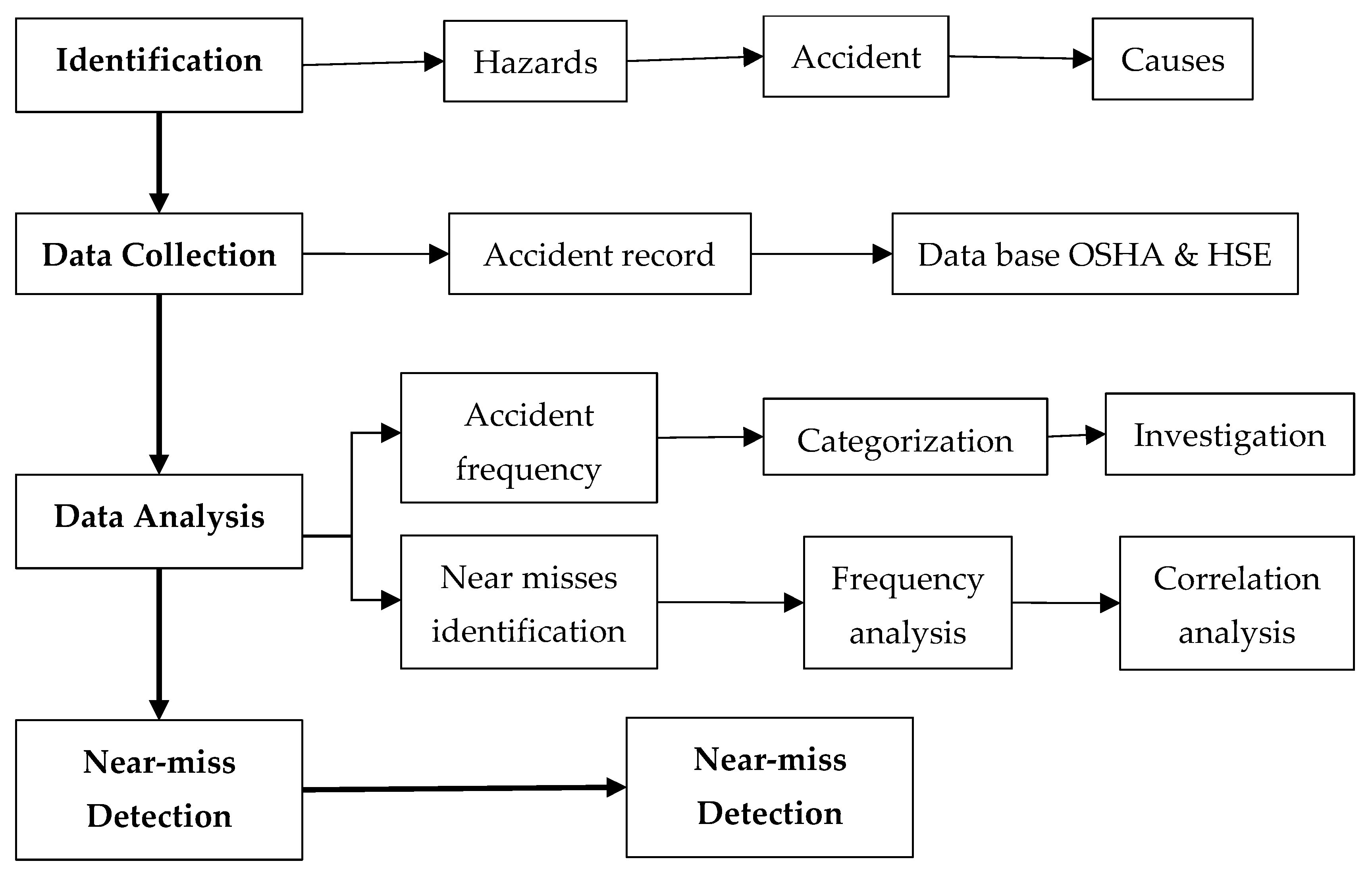
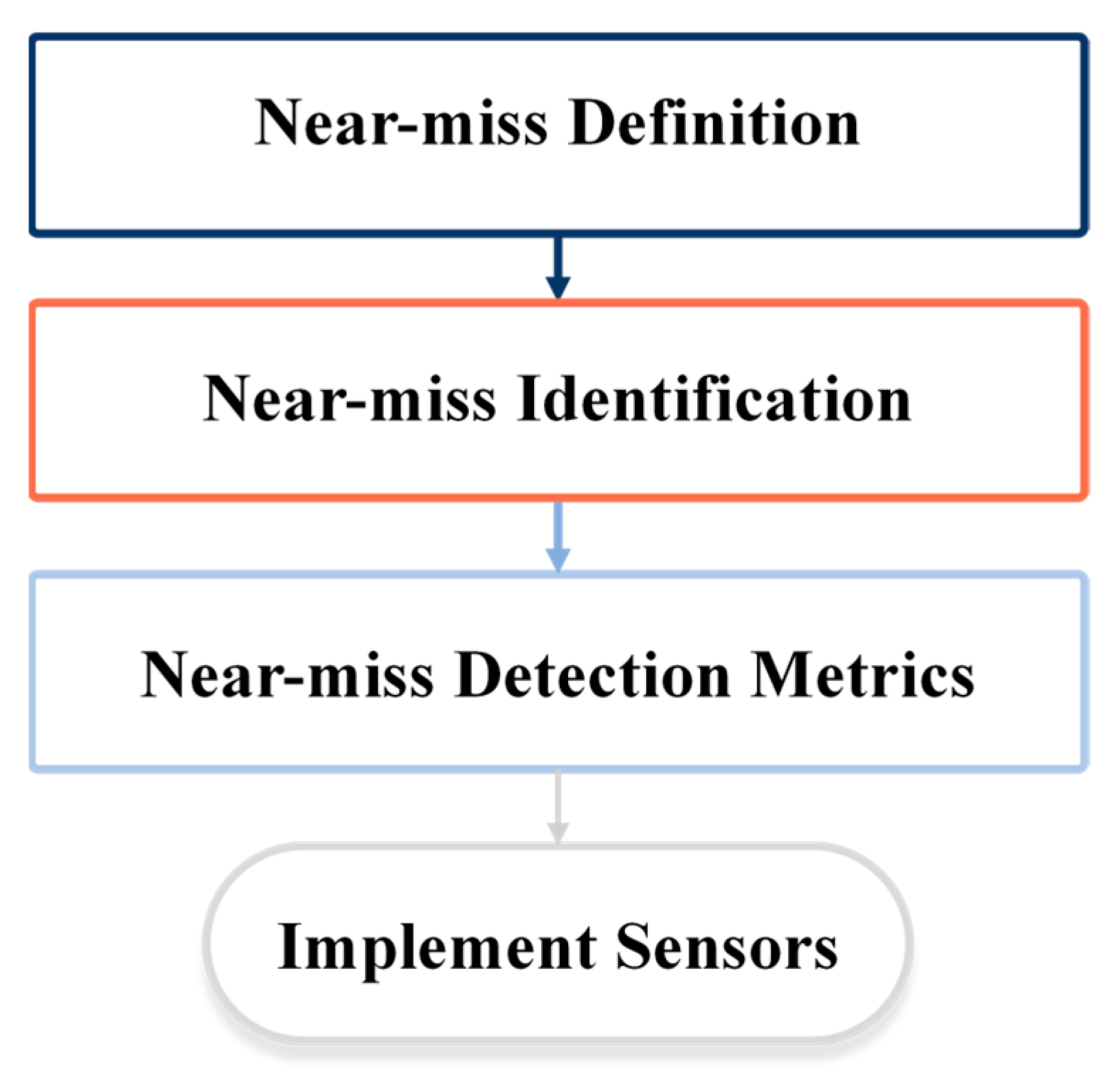

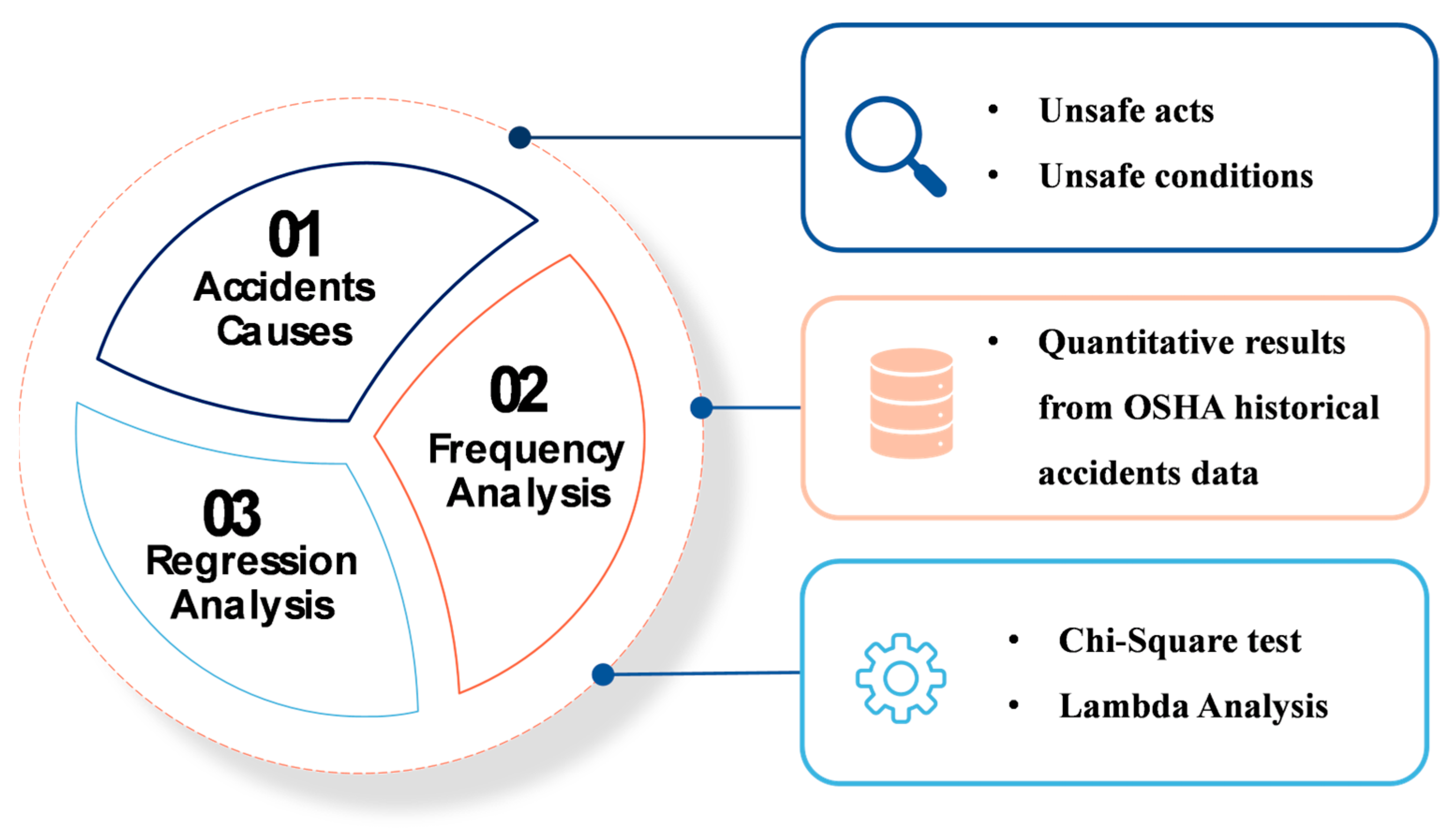
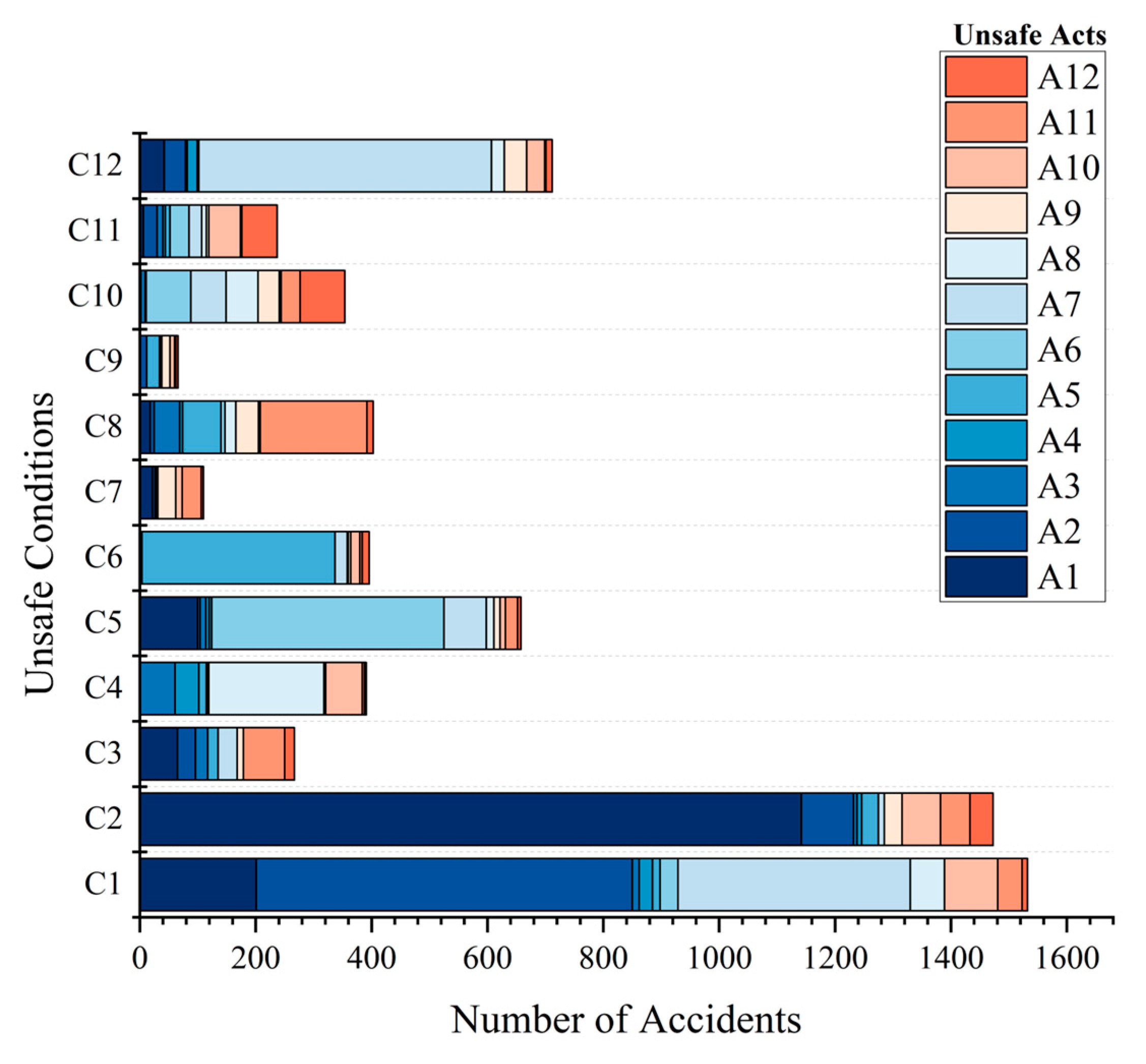
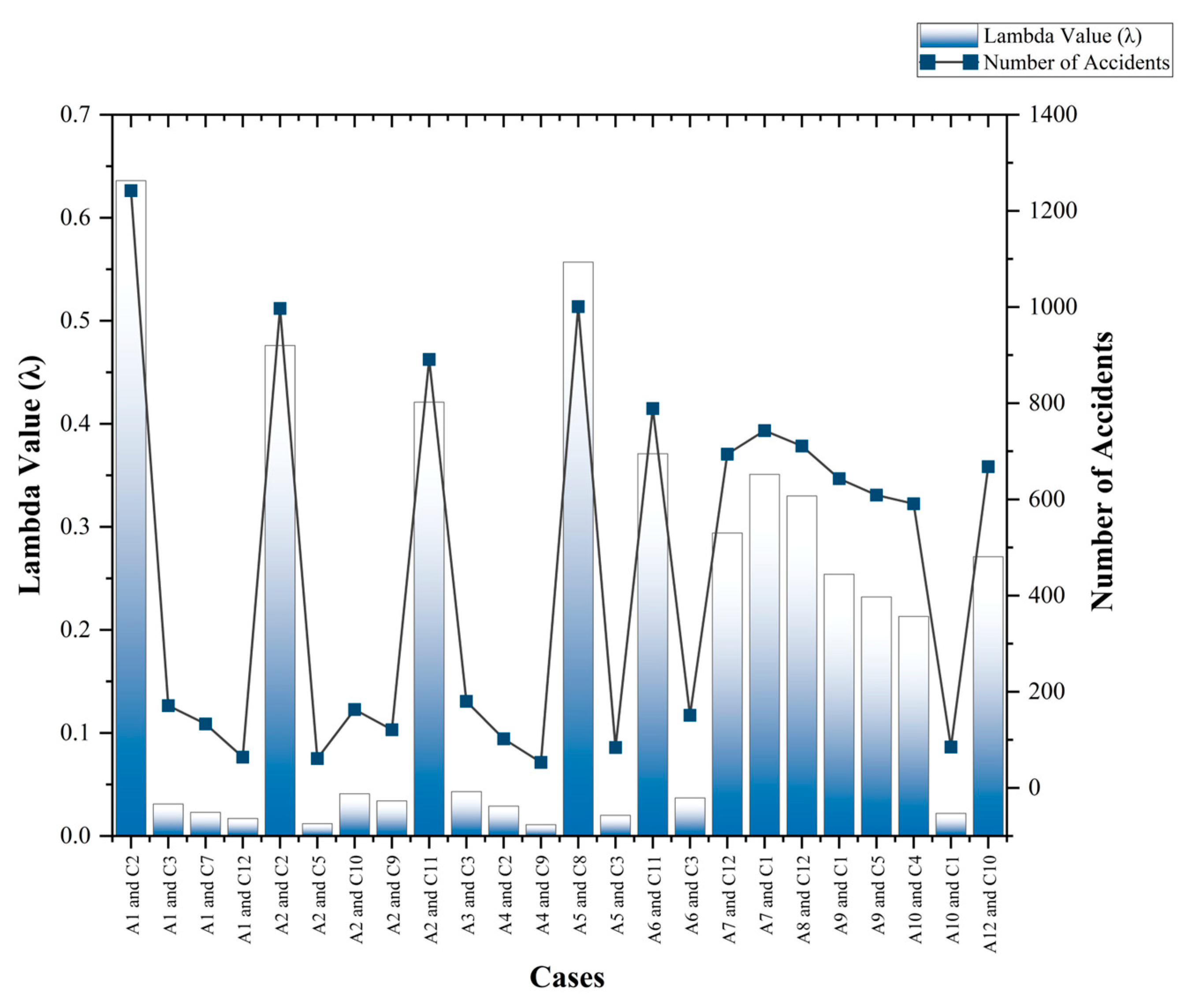
| S. No | Fall | Struck-by or -against | Electrocution | Caught-in or -between |
|---|---|---|---|---|
| 1 | From roof | By equipment | Contact with exposed wires | Collapse of structure |
| 2 | From scaffold | By falling or flying object | Contact with a damaged tool or machinery | Collapse of a trench (cave in) |
| 3 | From ladder | By object (other than falling, e.g., moving) | Electric shock by unknown cause | Trapped in or between objects |
| 4 | From building girders or other structures | Against a fixed or stationary object | Contact with overhead power lines | Pinned workers against other objects or the ground |
| 5 | On the same level (slip and trip) | Contact with underground, buried power lines | Contact of hand tools with an electrified wire | |
| 6 | From openings (e.g., trench) | By heavy equipment |
| ID | Date | Occupation | Accident |
|---|---|---|---|
| 316268895 | 15 February 2013 | Construction Laborers | Fall from Scaffold |
| Summary | Causes | ||
| The employee was working on a two-story scaffold. The scaffold was not fully planked. The employee was not wearing any fall protection. The employee fell from the scaffold. | Working at height/Not wearing PPE/Unsafely positioned scaffold | ||
| Unsafe Acts | Unsafe Conditions |
|---|---|
| A1—Approach to restricted areas | C1—Poor site layout |
| A2—No or improper use of PPE | C2—Unguarded floor or roof opening |
| A3—Inappropriate equipment usage | C3—Defective PPE |
| A4—Unsafe posture and position | C4—Unprotected excavations and trenches |
| A5—Equipment and tool inspection was incomplete or non-existent | C5—Unsuitable weather conditions |
| A6—Operating at an unusually high altitude | C6—Missing or defective warning sign |
| A7—Operating close to moving vehicles and equipment | C7—Places under unfixed materials/tools towards the edges |
| A8—Ignoring alarms and warning signages | C8—Unsafely positioned ladders and scaffolds |
| A9—Working close to overhead power lines | C9—Lack of training and poor experience |
| A10—Running heavy equipment near edges | C10—Lack of machine guards |
| A11—Worker carrying a heavy load | C11—Defective or damaged equipment |
| A12—Unauthorized use of equipment | C12—Unsuitable working conditions |
| S. No | Near-Misses |
|---|---|
| 1 | A1—Approach to restricted areas and C2—Unguarded floor or roof openings |
| 2 | A5—Equipment and tools inspection was incomplete or non-existent and C8-Unsafely positioned ladders and scaffolds |
| 3 | A2—No or improper use of PPE and C2—Unguarded floor or roof openings |
| 4 | A2—No or improper use of PPE and C11—Inappropriately installed or defective tools and equipment |
| 5 | A6—Operating at an unusually high altitude and C11—Inappropriately installed or defective tools and equipment |
| 6 | A7—Operating close to moving vehicles and equipment and C1—Poor site layout (congestion and overcrowding) |
| 7 | A8—Ignoring alarms and warning signages and C12—Unsuitable working conditions (e.g., limited visibility and excessive noise) |
| 8 | A7—Operating close to moving vehicles and equipment and C12—Unsuitable working conditions (e.g., limited visibility) |
| 9 | A12—Unauthorized use of equipment and C10—Lack of machine guards |
| 10 | A9—Working close to overhead power lines and C1—Poor site layout (congestion and overcrowding) |
| 11 | A9—Working close to overhead power lines and C5—Unsuitable weather conditions (heavy rain, poor lightning, high temperature, etc.) |
| 12 | A10—Running heavy equipment near edges and C4—Unprotected excavations and trenches |
| S. No | Near-Misses | Data Required |
|---|---|---|
| N1 | A1—Approach to restricted areas and C2—Unguarded floor or roof openings | Real-time worker location and location of the mentioned unsafe condition |
| N2 | A5—Equipment and tool inspection was incomplete or non-existent and C8—Unsafely positioned ladders and scaffolds | Real-time information on equipment/tools |
| N3 | A2—No or improper use of PPE and C2—Unguarded floor or roof openings | Real-time worker location, real-time information on PPE status, and location of the mentioned unsafe condition |
| N4 | A2—No or improper use of PPE and C11—Inappropriately installed or defective tools and equipment | Real-time information on PPE status and real-time information on equipment/tools |
| N5 | A6—Operating at an unusually high altitude and A5—Equipment and tool inspection was incomplete or non-existent. | Real-time worker location and real-time information on equipment/tool inspections |
| N6 | A7—Operating close to moving vehicles and equipment and C1—Poor site layout (congestion and overcrowding) | Real-time worker and vehicle location and construction site layout |
| N7 | A8—Ignoring alarms and warning signages and C12—Unsuitable working conditions | Real-time environment information |
| N8 | A7—Operating close to moving vehicles and equipment and C12—Unsuitable working conditions | Real-time worker and vehicle location and real-time environment information |
| N9 | A12—Unauthorized use of equipment and C10—Lack of machine guards | Real-time information on equipment/tools and real-time information on workers |
| N10 | A9—Working close to overhead power lines and C1—Poor site layout (congestion and overcrowding) | Real-time worker location, location of the mentioned unsafe condition, and construction site layout |
| N11 | A9—Working close to overhead power lines and C5—Unsuitable weather conditions | Real-time worker location and location of the mentioned unsafe condition and real-time information about weather |
| N12 | A10—Running heavy equipment/vehicles near edges and C4—Unprotected excavations and trenches | Real-time location of equipment/vehicles and location of the mentioned unsafe condition |
| Detection | Metrics | Parameters | Device/Sensor | Remarks |
|---|---|---|---|---|
| Location | Worker, vehicle, or equipment location | Geometric coordinates | GPS, IMU | Sensor-based system for monitoring environmental conditions in confined workspaces |
| Environment | Temperature | Celsius | Temperature sensor | Sensor-based system for monitoring environmental conditions in confined workspaces |
| Noise level | Decibel | Sound meter | ||
| Light intensity | Lumens | Light sensor | ||
| Rain | Mm | Rain gauge | ||
| Wind | Windspeed | Anemometer | ||
| Proximity | Distance from unsafe conditions such as from unguarded edge | Distance | Proximity sensor, distance sensor, cameras | Near-miss/proximity analysis; proximity monitoring for struck-by hazard identification |
| Identity | Worker information | Name, gender, age, experience, trade | RFID cards, database | Assessing workers’ perceived risk through monitoring workers’ physiological and emotional response; awkward posture recognition, work-related musculoskeletal disorders (WMSDs), ergonomics |
Disclaimer/Publisher’s Note: The statements, opinions and data contained in all publications are solely those of the individual author(s) and contributor(s) and not of MDPI and/or the editor(s). MDPI and/or the editor(s) disclaim responsibility for any injury to people or property resulting from any ideas, methods, instructions or products referred to in the content. |
© 2024 by the authors. Licensee MDPI, Basel, Switzerland. This article is an open access article distributed under the terms and conditions of the Creative Commons Attribution (CC BY) license (https://creativecommons.org/licenses/by/4.0/).
Share and Cite
Hashmi, F.; Hassan, M.U.; Zubair, M.U.; Ahmed, K.; Aziz, T.; Choudhry, R.M. Near-Miss Detection Metrics: An Approach to Enable Sensing Technologies for Proactive Construction Safety Management. Buildings 2024, 14, 1005. https://doi.org/10.3390/buildings14041005
Hashmi F, Hassan MU, Zubair MU, Ahmed K, Aziz T, Choudhry RM. Near-Miss Detection Metrics: An Approach to Enable Sensing Technologies for Proactive Construction Safety Management. Buildings. 2024; 14(4):1005. https://doi.org/10.3390/buildings14041005
Chicago/Turabian StyleHashmi, Filzah, Muhammad Usman Hassan, Muhammad Umer Zubair, Khursheed Ahmed, Taha Aziz, and Rafiq M. Choudhry. 2024. "Near-Miss Detection Metrics: An Approach to Enable Sensing Technologies for Proactive Construction Safety Management" Buildings 14, no. 4: 1005. https://doi.org/10.3390/buildings14041005
APA StyleHashmi, F., Hassan, M. U., Zubair, M. U., Ahmed, K., Aziz, T., & Choudhry, R. M. (2024). Near-Miss Detection Metrics: An Approach to Enable Sensing Technologies for Proactive Construction Safety Management. Buildings, 14(4), 1005. https://doi.org/10.3390/buildings14041005








